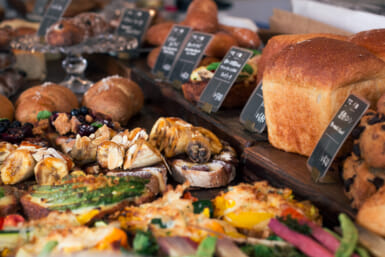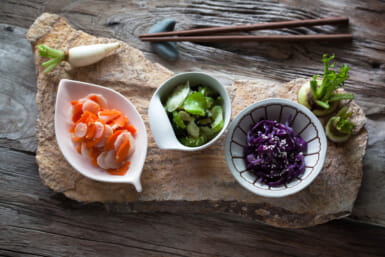with Elizabeth Andoh
Ginger is a lovely spice.
In western culture it is most often used in confections, in its dried and powdered form. Cookies, cakes and pies benefit from a gingery aroma.
There’s candied ginger, too. And candied fruit peels that have a zippier flavor thanks to ginger.
In the Orient, ginger is most often used fresh, or pickled as a spice or condiment to meat, fish and poultry. Fresh gingerroot called shoga, is available at any market in town—so why don’t you try added to the meaty recipes that follow.
Shoga-Yaki (ginger pork saute)
ingredients:
- 400 grams thin sliced pork loin
- 1 tablespoon fresh grated gingerroot
- 3 tablespoons each of shoyu and sake
- 1 teaspoon mirin
- 2 tablespoons salad oil
instructions:
1. Make a marinade by combining the grated gingerroot and shoyu, sake and mirin.
2. Carefully separate each slice of meat and dip the slices on both sides in the marinade. (Cut any very large or long slices of meat beforehand, if necessary.)
3. Set the meat slices to marinate, turning occasionally, for at least 10 minutes and probably no longer than 30.
4. Heat the salad oil in a fry pan over medium heat and quickly saute each slice, on both sides, until the pork is no longer pink.
5. Remove the slices to a plate until all the slices have been “pre cooked.”
6. Pour the remaining marinade into the fry pan. Add the precooked meat a few slices at a time. Saute them over high heat, reducing the marinade and glazing and browning the meat. Repeat until all the meat is similarly prepared. Eat warm or room temperature.
notes:
1. Approximately 100 grams of buta-niku usugiri (“thin-sliced pork”) will yield 3-5 slices and is considered a single portion by Japanese standards when part of a full meal. Increase quantities accordingly.
2. The fry pan may look discouragingly “burnt” after preparing shoga-yaki. Before cleaning, try deglazing the pan by sauteing 200-300 grams of fresh bean sprouts (moyashi) with a pinch of salt and a splash of sake. The beansprouts will make a fine tsuke-awase (“go-along thing,” i.e., accompanying garnish) to the meat. Other tsuke-awase possibilities might be shredded green peppers or cabbage. To clean the pan. soak in warm sudsy water for about 30 minutes before washing as you would any other fry pan.
3. Shoga-yaki makes a fine addition to a box lunch. Lay the meat slices (and sauted vegetables) over already cooked rice and pour a bit of the reduced marinade over all. The ginger acts as a preservative, so there is no need to fuss about refrigeration.
Tori Matsukasa (chicken patties)
ingredients:
- 400 grams ground chicken meat
- 1 egg (small)
- 3-4 tablespoons flour (in patties) plus up to 3/4 cup flour for dredging
- 2 teaspoons juice from grated fresh gingerroot
- 1 scant teaspoon salt
niijiru:
- 2 cups water
- 4 tablespoons sugar
- 6 tablespoons shoyu
- 2 tablespoons sake
instructions:
1. Beat the egg into the ground chicken meat. Add 3-4 tablespoons flour, the ginger-juice and the sale. Mix thoroughly.
2. Prepare niijiru by combining all the ingredients in a wide saucepan or pot, heating it through.
3. Sprinkle flour on your hands and over the seasoned ground meat. Form the meat into small, flat oval patties (about 3 inches long, 2 inches and 3/4-inch thick). The patties will be rather soft.
4. Score one surface of each patty with a dull knife and place the patties in the niijiru. Simmer over medium low heat 3-4 minutes before slipping over and cooking for 3-4 minutes again. If all the patties cannot be accommodated at one time in one layer, cook 5 or 6 patties in each shift.
5. Remove and set aside cooked patties to allow for the next shift if necessary. When all the patties have been cooked, return them to the remaining niijiru. Turn up the heat to high and carefully stirring and shaking, “glaze” the patties.
6. Serve warm or at room temperature. Figure on 3-4 patties per serving. The above quantities should yield about 20 patties.
notes:
1. These patties are great for picnic oben-to (lunch boxes) and smaller patties make good cocktail hors d’oeuvres.
2. These patties can be prepared through #4 of the instructions and frozen in the remaining niijiru for several weeks. Allow the patties and niijiru to thaw before proceeding with stage #5 and #6 of the instructions.








